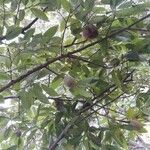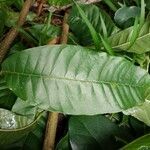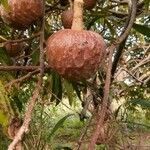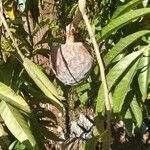Tree to 8 (–10) m high. Shoots and branchlets pubescent, glabrescent. Leaves: petiole 8–15 mm long; lamina narrowly elliptic to lanceolate or oblong-lanceolate, 9–20 (–30) cm long, 2–7 cm wide, acute or obtuse, shortly decurrent at base, acuminate at apex, glabrescent; secondary veins 10–15 pairs. Flowers several from internodal cymes, rarely leaf-opposed; pedicel 1.5–2.5 cm long, pubescent; submedial bract 1–1.5 mm long. Sepals depressed-ovate, 2–3 mm long, acuminate, pubescent. Petals pale green outside, yellowish with a crimson base inside. Outer petals narrowly ovate or oblong, 15–20 mm long, 10–12 mm wide, pubescent with pale brown hairs; inner petals minute scales or absent. Stamens 1–1.3 mm long. Carpels partially connate. Syncarp ovoid to heart-shaped or subglobular, to 12 cm long and wide, yellow brown to reddish brown; surface reticulately ridged around flat areoles or nearly smooth. Seeds 8–11 mm long, 5–6 mm wide. See also Du Puy (1993: 64).
A small tree up to 7.5 m tall. It has several branches near the base. Trees loose their leaves at some times of the year. New shoots have short brown hairs but older wood is smooth and shiny. The leaves are long and spear shaped with short leaf stalks. Around the edge of the leaf is a clear edge. The leaves smell when crushed. Flowers are greenish yellow. They occur in groups where the leaves join the stalk. Flowers occur on new wood growth. The fruit are reddish brown in colour and 10-12 cm across. There is a fine hexagonal pattern over the fruit. Inside there are large brown seeds. The fruit are edible but the seeds are not eaten.









